Retinal organization in the retinal degeneration 10 (rd10) mutant mouse: a morphological and ERG study
- PMID: 17111372
- PMCID: PMC2590657
- DOI: 10.1002/cne.21144
Retinal organization in the retinal degeneration 10 (rd10) mutant mouse: a morphological and ERG study
Abstract
Retinal degeneration 10 (rd10) mice are a model of autosomal recessive retinitis pigmentosa (RP), identified by Chang et al. in 2002 (Vision Res. 42:517-525). These mice carry a spontaneous mutation of the rod-phosphodiesterase (PDE) gene, leading to a rod degeneration that starts around P18. Later, cones are also lost. Because photoreceptor degeneration does not overlap with retinal development, and light responses can be recorded for about a month after birth, rd10 mice mimic typical human RP more closely than the well-known rd1 mutants. The aim of this study is to provide a comprehensive analysis of the morphology and function of the rd10 mouse retina during the period of maximum photoreceptor degeneration, thus contributing useful data for exploiting this novel model to study RP. We analyzed the morphology and survival of retinal cells in rd10 mice of various ages with quantitative immunocytochemistry and confocal microscopy; we also studied retinal function with the electroretinogram (ERG), recorded between P18 and P30. We found that photoreceptor death (peaking around P25) is accompanied and followed by dendritic retraction in bipolar and horizontal cells, which eventually undergo secondary degeneration. ERG reveals alterations in the physiology of the inner retina as early as P18 (before any obvious morphological change of inner neurons) and yet consistently with a reduced band amplification by bipolar cells. Thus, changes in the rd10 retina are very similar to what was previously found in rd1 mutants. However, an overall slower decay of retinal structure and function predicts that rd10 mice might become excellent models for rescue approaches.
(c) 2006 Wiley-Liss, Inc.
Figures
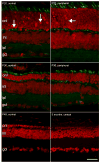
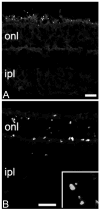
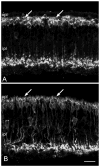



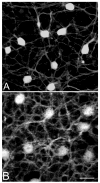



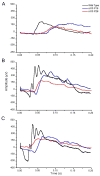


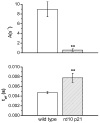


Similar articles
-
Long-term preservation of cone photoreceptors and visual acuity in rd10 mutant mice exposed to continuous environmental enrichment.Mol Vis. 2014 Nov 5;20:1545-56. eCollection 2014. Mol Vis. 2014. PMID: 25489227 Free PMC article.
-
Sex-related differences in the progressive retinal degeneration of the rd10 mouse.Exp Eye Res. 2019 Oct;187:107773. doi: 10.1016/j.exer.2019.107773. Epub 2019 Aug 22. Exp Eye Res. 2019. PMID: 31445902 Free PMC article.
-
Different effects of valproic acid on photoreceptor loss in Rd1 and Rd10 retinal degeneration mice.Mol Vis. 2014 Nov 4;20:1527-44. eCollection 2014. Mol Vis. 2014. PMID: 25489226 Free PMC article.
-
Progression of neuronal and synaptic remodeling in the rd10 mouse model of retinitis pigmentosa.J Comp Neurol. 2010 Jun 1;518(11):2071-89. doi: 10.1002/cne.22322. J Comp Neurol. 2010. PMID: 20394059 Free PMC article.
-
Optimal timing for activation of sigma 1 receptor in the Pde6brd10/J (rd10) mouse model of retinitis pigmentosa.Exp Eye Res. 2021 Jan;202:108397. doi: 10.1016/j.exer.2020.108397. Epub 2020 Dec 9. Exp Eye Res. 2021. PMID: 33310057 Free PMC article.
Cited by
-
Co-delivery of glial cell-derived neurotrophic factor (GDNF) and tauroursodeoxycholic acid (TUDCA) from PLGA microspheres: potential combination therapy for retinal diseases.Drug Deliv Transl Res. 2021 Apr;11(2):566-580. doi: 10.1007/s13346-021-00930-9. Epub 2021 Feb 27. Drug Deliv Transl Res. 2021. PMID: 33641047
-
Mesenchymal Stem Cell-Based Therapy for Retinal Degenerative Diseases: Experimental Models and Clinical Trials.Cells. 2021 Mar 7;10(3):588. doi: 10.3390/cells10030588. Cells. 2021. PMID: 33799995 Free PMC article. Review.
-
Activation of the molecular chaperone, sigma 1 receptor, preserves cone function in a murine model of inherited retinal degeneration.Proc Natl Acad Sci U S A. 2016 Jun 28;113(26):E3764-72. doi: 10.1073/pnas.1521749113. Epub 2016 Jun 13. Proc Natl Acad Sci U S A. 2016. PMID: 27298364 Free PMC article.
-
Progesterone Attenuates Microglial-Driven Retinal Degeneration and Stimulates Protective Fractalkine-CX3CR1 Signaling.PLoS One. 2016 Nov 4;11(11):e0165197. doi: 10.1371/journal.pone.0165197. eCollection 2016. PLoS One. 2016. PMID: 27814376 Free PMC article.
-
Modulatory influence of stimulus parameters on optokinetic head-tracking response.Neurosci Lett. 2010 Jul 26;479(2):92-6. doi: 10.1016/j.neulet.2010.05.031. Epub 2010 May 19. Neurosci Lett. 2010. PMID: 20488227 Free PMC article.
References
-
- Acland GM, Aguirre GD, Ray J, Zhang Q, Aleman TS, Cideciyan AV, Pearce-Kelling SE, Anand V, Zeng Y, Maguire AM, Jacobson SG, Hauswirth WW, Bennett J. Gene therapy restores vision in a canine model of childhood blindness. Nat Genet. 2001;28:92–95. - PubMed
-
- Bennett J. Gene therapy for retinitis pigmentosa. Curr Op Mol Ther. 2000;2:420–425. - PubMed
-
- Bowes C, Li T, Danciger M, Baxter LC, Applebury ML, Farber DB. Retinal degeneration in the rd mouse is caused by a defect in the beta subunit of rod cGMP-phosphodiesterase. Nature. 1990;347:677–80. - PubMed
-
- Breton ME, Schueller AW, Lamb TD, Pugh EN., Jr Analysis of ERG a-wave amplification and kinetics in terms of the G-protein cascade of phototransduction. Invest Ophthalmol Vis Sci. 1994;35:295–309. - PubMed
Publication types
MeSH terms
Substances
Grants and funding
LinkOut - more resources
Full Text Sources
Other Literature Sources
Molecular Biology Databases

